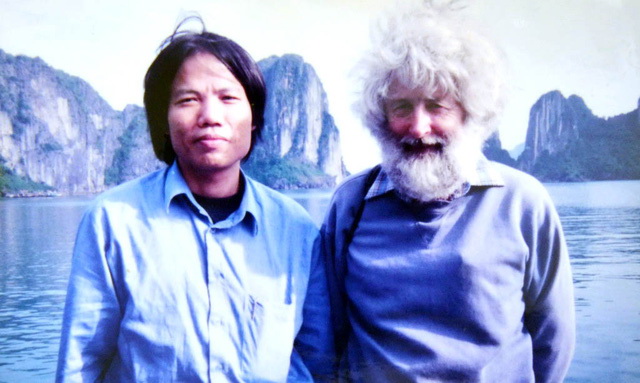Vietnamese scientists and students and their Australian friends, including one revered professor, are credited with the introduction of the Internet to Vietnam over 20 years ago.
>> The Internet turns 20 in Vietnam: P1 – Forerunners
The respected young academics from both countries were instrumental in the ushering in of the Internet into the Southeast Asian country in the early 1990s.
One of the first foreign experts to make Vietnam’s connection to the global grid possible was Professor Rob Hurle from the Australia National University (ANU).
Tuoi Tre (Youth) newspaper reporters recently contacted Prof. Hurle during his stay in Germany to visit his son.
“I’m delighted to tell this story, which reflects one of the most intriguing parts of my life,” he wrote in an email.
As a young man, he taught biology at high schools in Victoria, Australia upon his graduation from university.
He did not take a keen interest in computer science until four years later, and joined the Australia National Center of Natural Sciences.
In 1987, Hurle became a professor at ANU, an information technology expert and a Southeast Asian researcher with a perfect command of Bahasa, whose usage typically refers to the languages of Indonesia and Malaysia.
“Despite carrying out extensive research into Southeast Asian languages and cultures and traveling widely across the region, I somehow had never set foot in Vietnam,” the 77-year-old admitted.
 |
| Professor Rob Hurle from the Australia National University |
In the late 1980s and early 1990s, students at ANU would use a mainframe computer for statistical work and related tasks.
The personal computer, which was not powerful enough to perform such tasks then, was mostly used to type documents and send emails.
Prof. Hurle shared his disturbance at learning that overseas Vietnamese students had limited use of personal computers, preventing them from putting what they had learnt in Australia into practice upon their return to their home country.
The nagging question prompted him to travel to Vietnam in 1991.
“I brought with me a hefty modem and gifted it to Pham Bich San, one of the Vietnamese students in Australia, so that he and others could connect to the mainframe computers in Vietnam more easily,” the professor recalled.
“Totally uninformed about Vietnam, I had not been aware that the bulky modem would be a burden, as computer engineers in Vietnam, who earned a mere US$20 per month, could hardly afford phone calls from Vietnam to Australia at $5 per minute,” he added.
This reality encouraged the scientist to devise ways to connect to Vietnam through an international phone toll of $2 per minute, which engineers in Australia, whose monthly salaries were approximately $3,500, could afford.
A few months later, Prof. Hurle returned to Vietnam and contacted an overseas Vietnamese in the U.S., who suggested that he approach Tran Ba Thai from the Institute of Information Technology in Hanoi.
“By then we had made strides in substituting the mainframe system with smaller yet higher-configuration computers adopting the UNIX system [a family of multitasking, multiuser computer operating systems] at ANU,” he added.
Prof. Hurle, Thai and a few other colleagues then embarked on experiments in connecting computers in Vietnam and Australia through landline phone lines.
The Aussie designed new pieces of software for the UNIX system, so that modems could be utilized to link computers in Vietnam by allowing users access to the UNIX system before they could connect to the Internet.
The experiments were a success.
And Thai was then able to send emails to his colleagues around the world, using the email address hanoi@coombs.anu.edu.au.
Prof. Hurle added that he and Thai had talked on the phone and never met in person at that stage.
In September 1993, Telstra Corp Ltd., Australia's biggest telco company, sponsored a conference in Hanoi, and invited the professor to the event, where he sat down with Thai for further discussions on fostering the growth of the Internet in Vietnam.
 |
| Engineers work at Quang Trung Software City in Ho Chi Minh City. Photo: Tuoi Tre |
Reparation
Prof. Hurle revealed that he also helped government agencies, banks, research institutes and national libraries in China, Bangladesh and the Philippines with their Internet connections during that time.
“My greatest effort and time, however, were expended in Vietnam for different reasons,” he noted.
One of the reasons was his encounters with overseas Vietnamese students who had a voracious appetite for knowledge but were unable to put it into practice.
“This spurred me on to seek ways to give them better access to the Internet world,” he said.
He was also overwhelmed with a sense of guilt as Australia had participated in the American war in Vietnam, which ended in April 1975.
“As an Australian, I desired to do something in recompense for our wrongs,” he confided.
While working with agencies in the Philippines, Prof. Hurle learned that the domain .ph had been registered by an individual user, who wanted to trade it to the government for a huge sum.
Foreseeing a similar predicament in Vietnam, he advised Thai to promptly register for and acquired the .vn domain in 1994.
|
Piloting milestones in Vietnam The Internet pilot program in Vietnam stemmed from the partnership between Tran Ba Thai and his associates and Professor Rob Hurle’s group from the Australia National University to launch VAREnet, short for Vietnam Academic Research & Educational Network, on a trial basis in 1994. Back then, NetNam was a service network under the Information Technology Institute and had yet to become the enterprise it is today. The National Center for Science and Technology Information, under the Ministry of Science, Technology and Environment (now the Ministry of Science and Technology), connected to the Netherlands’ Toolnet in 1994. In 1995, the Center of Science and Technology, under the Ho Chi Minh City Department of Science, Technology and Environment, liaised with a networking node in Singapore to form the so-called HCMCNET. One year later, Vietnam Data Communication Co. (VDC), which belongs to Vietnam Posts and Telecommunications Group, connected to the U.S.’s SprintLink, a tier-1 global Internet service provider network that provides services through an OC-192 Internet backbone, at two points in Hanoi and Ho Chi Minh City through two international portals operating at 64kb per second. |
Like us on Facebook or follow us on Twitter to get the latest news about Vietnam!



















































